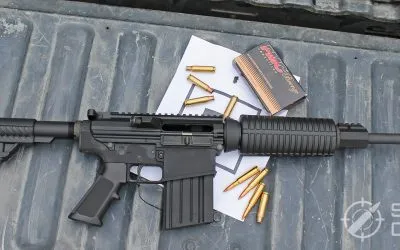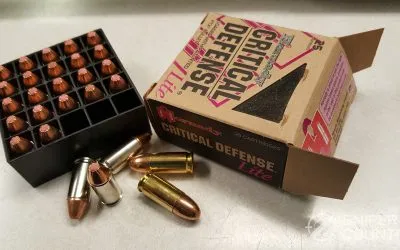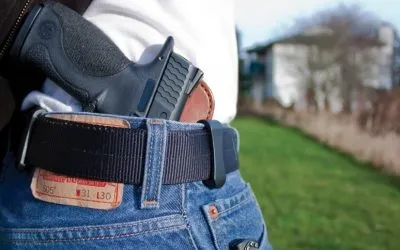I just traded for a fun little gun. I got one of these...


[toc]This is Charter Arms’ Target Pathfinder .22 LR with a 4.2-inch barrel. They also make a snubby version but I wanted the longer barrel and adjustable rear sight. If you’ve read many of my articles on this site about handguns, you would probably think that I shoot centerfire cartridges pretty much all the time, since I’m also into reloading. However, I do like a good .22 revolver. I also like accurate .22 rifles - I have a Ruger 10/22 rifle that will shoot the acorns off an oak if I do my part. Now that .22 ammo is in good supply and reasonably-priced, I plan on shooting a lot of it. (“Reasonably-priced” does not mean that the prices are like they were in 1978 when I could buy a brick of 500 for $5 but, considering the shortage and gouging a few years ago, prices aren’t that bad). So... why a .22 revolver in a world awash with self-loading pistols? Simple – I like revolvers. If you’ve read my article on revolvers, you’d know that I am a big fan. Why? There are advantages...
The Advantages Of A .22 Revolver
First, why not include autoloaders as well? Don’t they have any advantages? Of course they do. I once owned a Ruger Mk. II 22/45 that was very accurate. It’s easier to mount an optic on most autoloaders and faster to reload them than revolvers. I own and carry different autoloaders for defense purposes, so I do like them - I have nothing against semiautos. I just like revolvers for some purposes. There’s just something about being able to load .22 Shorts into the cylinder and having a true mouse gun for pests, then turning around and putting some Stingers or similar ammo in the gun and having a handy, accurate small-game harvester. I prefer an adjustable rear sight in order to take advantage of the ability to adjust the sight picture for whatever ammo I’m shooting. That way, I can shoot several brands of ammo and decide on a keeper load, then set the rear sight for it. (There will be more on ammo later). Revolvers are old-school, but so am I. They still get the job done.
OK...So Why A Pathfinder?

Or, if you prefer gold lettering...

...easily done with a paint pen. Sometimes I do this just to set the gun apart a bit. Note the bleed-over on the side of the front sight ramp from my application of orange nail polish...more on this later.
I can hear some of you out there asking “why in the world a Charter Arms Pathfinder in this world of Smith & Wessons and Rugers and others?” Because it was there. (Like the old mountain joke - “why’d you climb that mountain? Because it was there”, or something to that effect). I’d bet many guns get purchased “because they were there.” I’d seen this little guy in Duane’s (my local gun shop) gun case for a while and wondered how it might shoot. So, like most of you, I turned to the School of YouTube-ology in order to become an “internet expert” on the Pathfinder. (Translated, I watched a lot of videos about the gun). I found out that most owners really liked theirs and use them a lot for plinking or other purposes. I had owned the original Charter Arms Bulldog .44 (the infamous “Son of Sam” gun), and liked it a lot:

They must have something going for them, as I found out that one of my internet gun “heros”, Hickok45, has three .44 Charter Arms Bulldogs. He certainly wouldn’t own something that didn’t work as advertised.
The second reason I got the Pathfinder was because it was affordable. Being a retired teacher, I have to be careful as to how I indulge my gun habit and the gun was very reasonably-priced. It certainly shoots like a more-expensive gun, to be sure.
BONUS OFFER: Get your free shooting range targets to print at home!
Get your free targets to print at home!
History
Charter Arms has had a rough row to hoe in terms of bankruptcies, lawsuits and other negative experiences. Originally founded in 1964 by former Colt/Ruger/High Standard employee Doug McClenahan, the company was located in New England (where it is today). His first product was the “The Undercover” in .38 Spl. This gun was snapped up by police back then as a hideout gun and is still selling very well today. Charter Arms revolvers do not have a sideplate – their frames are one-piece in order to be able to withstand slightly higher-pressure ammo. They also have fewer parts than other brands of revolvers.
After a couple of name changes due to bankruptcy/new ownership (Charter 2000, Charco), the company was finally renamed Charter Arms and located in Shelton, CT.
A Safe Gun
Charter Arms revolvers are known for, among other things, using a very safe action. A transfer bar system is utilized to make the revolver totally safe to carry, as it cannot fire unless the trigger is pulled fully to the rear which moves the transfer bar into position to transfer the energy of the hammer to the firing pin. Several other makers use this system as well. My Pathfinder utilizes a transfer bar (below). You can carry all chambers loaded, whether you’re shooting a .22, .38, .357 magnum, or .44 revolver - all the guns use this system and have since 1964 when they were introduced. Here’s a screenshot of their website where we find out that Charter Arms actually invented the transfer bar system:


The Pathfinder was introduced during the Charter 2000 phase in an effort to expand the product line a bit. Here’s the most complete listing of calibers produced by Charter Arms that I can find. Please remember that Charter Arms makes only revolvers, no semi-autos, and the longest barrel that they install on a gun is 4.2 inches.
- .22 LR/Magnum
- .32 H&R Magnum
- .38 Special
- .357 Magnum
- 9mm
- .40 S&W
- .41 Magnum
- .44 Special
- .45 ACP
- .45 Colt

If you like the Pathfinder, with its 4.2-inch barrel and adjustable rear sight but want a more substantial caliber, you can get a Target Bulldog (.44 Spl.) or Mag Pug (.357 Mag) in a five-shot version. I remember that they, once upon a time, made a five-inch version in either .357 or .44 Spl. - can’t remember which – but it’s not listed now on their site.
The Pathfinder has many siblings and cousins. Perusing the Charter Arms website, I saw the following models in current production. Please note that with the exception of the .22 models, most all of these guns are 5-shooters:
Nitride Models – several of the better-sellers with a hard, nitride finish
Pathfinder - .22 LR and .22 Magnum, with either a 2-inch barrel/fixed sights or a 4.2-inch barrel/adjustable rear sight
Undercover – the original, in different finishes and different hammer configurations
Undercover Lite – Aluminum-framed Undercover that weighs in at 12 ounces
Chic Lady – an Undercover Lite with a pink anodized frame
Southpaw – MY kind of gun! A mirror-image of an Undercover Lite, set up for lefties. Comes in pink, too!
Undercoverette - .32 H&R Magnum snubby
Bulldog – 2.5-inch-barreled .44 Special with various hammer configurations with one model having a 4.2-inch barrel and adjustable rear sight
Pit Bull - “Autoloader” calibers, using a tricked-out spring-loaded extractor that does away with moon clips
Mag Pug - .357 Magnum snubby, with one model having a 4.2-inch barrel and adjustable rear sight
On Duty – A 12-ounce .38 with a partially-shrouded hammer
Off Duty – A 12-ounce .38 with a totally-enclosed hammer (think S&W 442)
Please check here for more details on any of these models.
Now, back to the gun at hand, the Pathfinder .22...
Popular Articles
Pathfinder Specifications & More...
Let’s examine the Pathfinder in a little more detail. Some specs are from Charter Arms’ Pathfinder web page (here). I have added a couple of specs to round things out....their site’s spec list isn’t too detailed.
| Caliber: | .22 LR (.22 Magnum available at the same price; identical dimensions and price) |
| Action: | SA/DA |
| Capacity: | 6 |
| Weight: | 24 ounces |
| Finish: | Matte stainless steel |
| Sights: | Ramp front with wide post, adjustable rear |
| Cylinder Rotation: | Clockwise |
| Grips: | Rubber with finger grooves (many after-market grips are available) |
| MSRP: | $409 |
| Real-World Price: | $335-$360 |
Some Things I Really Like:
- It’s very accurate with certain ammo (see below)
- The adjustable rear sight. For elevation, turn the top screw. For windage, loosen one screw, tighten the opposing screw.


- Fairly inexpensive
- Very tight cylinder lock-up


- Ergonomics – this gun sits very well in my hand(s) and points naturally, due in no small part to the really great grips

- Muzzle crown – the muzzle has a slight crown to help protect the rifling in the event the gun is dropped.

Some Things For Charter Arms To Work On:
- Rough finish. The finish is very rough in places, especially on the barrel under the cylinder extractor rod and in the groove on the other side of the barrel. This is not a deal-breaker, but a little polishing would help.

- Rough edges. The trigger guard’s edge, especially where my second finger lies against it, is sharp. I polished it a bit in order to make it more comfortable to shoot.

- Cylinder extractor rod is stiff – it moves in two sections, like it’s a two-piece rod. The outer part is stiff, like there are a lot of burrs in the area it moves into.

- Front sight post is very wide...not much light on either side of it when lined up in the rear sight. It fills the slot. The post is also very “sharp”, for lack of a better word. It would scrape leather. As long as you don’t physically shorten the post, it’s perfectly OK to make it smoother by stoning or other method. This will help protect your leather holsters and maybe your hide.

Carrying The Pathfinder
This gun fits many holsters well and is a joy to carry. I have one of those inexpensive Blackhawk nylon holsters that has the mag carrier on the front with a strap – you know the one, it has a moveable metal clip and a nylon belt loop on both sides to make it ambidextrous. It also has a couple of snap-straps with a popsicle stick/tongue depressor to insert between the strap and velcro when you want to move the straps. The holster was obviously made for a semiauto. Even so, the gun is a perfect fit for this medium-sized holster. The straps are not really needed, as the fit is tight enough without them.

Would I prefer a nice leather holster? Certainly, but I had this one in my holster stash and don’t mind altering it a bit for a better fit. I was considering cutting the front mag pouch and strap off as I have done in the past but got to thinking that it may come in handy as a place to carry a knife or squirrel call, securely strapped in. Twenty-four ounces on your belt with six rounds immediately available is hardly noticeable but sure would come in handy if you needed a gun in a hurry while on a hike or in the woods. Even considering the areas that Charter Arms could improve on this gun, it is a solid buy and the gun that I reach for when I just want to have fun shooting. If you are into .22 handguns, you might want to check it out. Speaking of checking something out, let’s look at accuracy with this gun and different types of .22 ammo...
Ammunition & Accuracy
I tried six different types of ammo in the Pathfinder. Only five are shown below, as the sixth type was Remington Golden .22 round nose loads – I was unable to find more for testing after I ran out so I omitted them from the spreadsheet. I will include a target shot from them – they technically grouped the best. I hope to find more soon.
Here’s a screenshot of my spreadsheet that shows ballistics from Remington Thunderbolt, Aguila, CCI Mini Mag, Winchester and Federal Champion rounds.
Bullet: Brand: Velocity: Energy: S.D.: E.S.: No. of Shots: Comments:

Here are some target shots. I was standing, about 12-15 yards at my backyard range, just to get a rough idea of how the gun would handle different ammo. These are the first targets shot by this gun. I used a two-hand hold but other than that, no support from a bench. (I did bench test these and other loads later, but I wanted to show the very first loads I put through the gun).






Some thoughts about .22 ammo...
It’s a little weird that the load with the greatest extreme spread, the Remington, would arguably turn in the best group. The Thunderbolt will be my go-to round for the time being. Unless I can find more Remington Golden .22s, this will do.
I did not try hyper-velocity rounds like the CCI Stinger, et al. Maybe I will another day, but I was just wanting to test what I had on hand in order to find something that shot well without having to go buy several more boxes of ammo.
Federal Champion and CCI Mini Mag .22 ammo usually shoots well for me in other guns...this one didn’t like them at all. I even gave them a second chance, no joy.
It’s interesting to note that another .22 handgun I owned really liked the CCIs, and my Ruger 10/22 likes Aguila ammo, but this Charter Arms likes Big Green’s stuff.
The Take-Away
So...what does this prove? It says a couple of things to me. First, the little 4.2-inch-barreled Pathfinder is capable of some pretty decent accuracy with the right ammo. I like 4-or-so-inch barreled revolvers – I once knocked a squirrel out of a tree at about 40 yards with a 4 ¾"-barreled Ruger Single-Six – so I’m pretty happy with this one. I’ll keep experimenting with different ammo as I run across it. That’s the fun part – experimenting. The way your face lights up as you see, with each successive shot, no extra holes appearing in the target because they are grouping themselves into a tight little space...shooting through your chronograph and being surprised at the velocities you get...putting the sights on a wildflower bloom about 25 yards away and having it disappear with the shot... I’ve done all these and can truly state this gun is fun. It comes from a company that cares about their product and how you care for it, as this photo shows:

Not too many makers go into the detail that Charter Arms does just to explain how to adjust a sight, as an example of the type of company they are. Their customer service has earned a very decent reputation – that's important.
BONUS OFFER: Get your free shooting range targets to print at home!
Get your free targets to print at home!
Sight Modifications
OK, it’s a .22 revolver, not a competition race gun...what do I mean by sight mods? My 67-yr.-old eyes have a problem focusing on the rear sight/front sight/target all at once (I know, focus on the front sight and center it in the rear sight while placing it on the target-been there, done that for 40 years...easier said than done). It’s even worse when the front sight is the same color as all the other barrel metal. So I used orange-ish nail polish and a white Ultra-Fine paint pen to highlight the front and rear sights, respectively. This “paint job” isn’t up to my usual standards – I'm pretty picky about sights and highlights thereon – but, for now this will work. The trick is to do two things in addition to just making the sights more visible – you must not do anything that will detract from the sight picture like extra-long lines, etc. and you must keep the markings very even, minimal & symmetrical on the rear sight blade. It’s really hard to get the lines even on the rear sight by drawing them freehand, so you must be very careful. I still have some touch-up to do here, but I’m showing you this not to elicit oohs and ahhs (it’s pretty crude, by my standards) but to show you that you can modify your guns with nothing more than a $4 bottle of nail polish and a $2.24 paint pen from Walmart. A steady hand helps.
What I will do is touch up the rear sight’s white in front, on the bottom with a black fine-point Sharpie to make the white more even & defined, and make a definite start/end line on the front sight’s orange “bar”. Some guys just paint the whole front sight, but I like to have a definite line where the color stops – that way, if you have to employ hold-over, when your front sight goes silver, you know you’re too high. A matte spray will go on the front sight as well, so it doesn’t shine. I might even de-horn the rear sight blade’s corners to make them less likely to catch on clothing or whatever. That you can do with a file and cold blue touch-up. It makes the gun handle better, for me at least. I mentioned above about taking the sharp edge off the front sight...rounding edges on sights helps me, at least, to enjoy carrying a gun a little more as I don’t get gouged or scraped by sharp edges.


My shooting history dates back to my old S&W Model 28 days (late 1970s), and on from there to my current Model 629. The Smiths all have the white outline on the rear sight blade and a red insert up front, so that’s what I’m used to on a plinking/hunting/target revolvers. Three-dot or fiber optic sights are fine on my carry guns, but I’m pretty old-school on the other guns’ sights.
Accessories
Speaking of modifications, Charter Arms offers a decent selection of accessories for their guns. These range from holsters and grips through speedloaders, apparel, parts and other items. Here are screenshots for the holsters and grips that are available:


As you can see, the company is trying to attract female shooters with pink items ranging from gun frames...

… to grips. They also have some nice wooden, Crimson Trace and Classic grips as well. The advantage of making basically one frame size is that they can offer lots of different styles of grips, holsters, etc. without having to invest in a football-field-sized-building to house the machines needed to make a ton of accessories for many different models and sizes of guns. These accessories are reasonably-priced and look to be well-made. I am partial to wooden grips on recreational guns of this type and have made many sets of walnut grip panels over the years. The wooden ones here look very professionally-made and would be a welcome addition.
To Sum Up...
I like the little gun. If the barrel was about an inch shorter, we might call it a “kit gun” - that general-purpose, stick-it-in-your-backpack do-it-all .22 that you hike with. As for me, I’ll take that extra inch of barrel and the adjustable rear sight. It’s my personal kit gun. It will reside on my hip when I venture forth into yonder great backyard in pursuit of...mushrooms? solitude? squirrels? sick racoons like the one who eats our cat’s food in the daytime? Who knows what’s out there – just know this gun will do all you ask of it in any of these, or similar, circumstances.
If you are looking for an inexpensive .22 that doesn’t weigh much, is accurate and is capable of firing many different types of ammo without fear of having failures to feed, extract or eject, this might be your gun. Revolvers tend to get a bad rap today but there are those of us who still like them. (To see how I feel about them in a little more detail, read my article on revolvers here).
A semiauto .22 is a fine thing – I've been really looking at the S&W Victory with an added red dot sight and the Browning Buckmark, to name a couple – but for everyday totin’ (or as gun writer John Taffin calls them, “perfect packin’ pistols”) around yore ol’ homestead, the little Charter Arms is just right. Check one out – you might be surprised! Let me know how you feel about this gun below. Stay safe and keep shootin’!










![9mm Glock Models [Ultimate Guide]](https://snipercountry.com/wp-content/uploads/2018/10/Glock-17-vs-Glock-19-vs-Glock-26-vs-Glock-41-vs-Glock-43-WM-400x250.webp)
![Handgun Caliber Chart [2025 Ultimate Guide]](https://snipercountry.com/wp-content/uploads/2018/10/Handgun-Caliber-Comparison-400x250.webp)
![Rifle Calibers [Ultimate Guide]](https://snipercountry.com/wp-content/uploads/2018/12/Header-1900-400x250.webp)








15 Responses
Their lockwork leaves a lot to be desired. It’s not up to the same level of quality and design as Colt and Smith & Wesson.
Tom, I agree but you have to remember that you can buy about two Pathfinders for each Model 17, or close to it. These guns are made for folks who can’t afford the brands you name and they do a pretty good job, considering that they don’t cost all that much, Plus, they’re made in the U.S. Good point – thanks for writing!
I could be mistaken about the transfer bar, but Iver Johnson’s little 32 S&w break top pistols from the late 1800′ early 1900’s were advertised with the hammer the hammer safety. My pair both feature a transfer bar safety that move into position in both sa/da.
Randall, I think I remember that “hammer-the-hammer” slogan. I was just going off the info I’d found. It was a great innovation, and still is. Thanks for writing!
Mike,
my revolver is the target .22 mag. It is anything but a target gun. As we speak, the revolver is making its way back to Charter Arms for a second time. It will shoot 30 grain bullets sort of well but 50 grain .22 mags KEY HOLE at 10 yards off a sand bag! I deduce that the twist rate is too slow. One totally unacceptable issue is that the trigger is way too curved. It is so bad that 6 rounds leave one’s finger in pain.
I understand that C. A. is second tier but it should not be second rate at any price.
Stu, I totally agree. My experience with Charter has been decent – as I said, I owned a Bulldog in the ’70s. It was not perfect, but got the job done – some minor fit/finish issues. Charter is definitely in the tier 2 category but they make some nice guns, for the most part. That said, you should not be getting keyholes at 10 yards (or any distance!), though. I’m sorry to hear you’re having these issues. My .22 LR Target is working as expected, with the right ammo. Hopefully yours will come back in great shape – keep us posted here when it’s back and you’ve shot it, OK? Thanks for writing!
Hi Mike, I am interested in the Pathfinder 22 revolver…I enjoy all the research before I buy. Your experience with the Pathfinder is a refreshing read . I learned a lot and will come back and check out your recommended ammo after I buy. Like you, I have a soft spot for revolvers…maybe I watch too many old Westerns!!!!
Rick, I’m with you on theold westerns! I’m glad I could help you with my review. I carry mine around the yard when I’m outside – we live in the woods and it’s squirrel season…thanks for writing!
I recently purchased a used 2 inch 8 shot pathfinder and at first I was disappointed that the trigger would lock up. I bought this used but it has gotten much better after 5oo plus rounds. I don’t think this gun was shot very much. I painted my front sight with white finger nail polish and that helped alot. The double action is much better than when I first got it. Finding bulk ammo sure isn’t easy these days…
JIm, yup, you’re right about the ammo situation – hopefully that will get better soon. As for the trigger, one of the things I do to help the parts wear in is to dry-fire the gun many times (if it’s a gun that you can do that with). If it’s a no-dry-fire gun, just shooting the snot out of it will help wear the parts in (in most cases) as you’ve undoubtedly found out. Thanks for writing!
I just bought a 8 shot target pathfinder . Have just passed the 500 round mark. I am having a couple of problems with the gun. Single action shooting isn’t working very well you almost have to work with the trigger to fire it. The double action is very smooth and works great. Any idea what a reasonable break in period might be? I am also having some ejection issues with getting the spent ammo out of the cylinder. This is my 2nd charter arms 22lr. Hopefully this one will be as good as the first one, once it is broken in.
Jim, I’d think 500 rounds would be more than enough to break the gun in. Sounds like you need to call Charter Arms – have you done that yet? to me, It’s interesting that the DA works well with the SA not so much. Maybe a sear issue with the SA notch on the hammer? I’m not a gunsmith, just a guess. I’d call them – let us know what happens, OK? Thanks for writing!
Mike, I took your advice and called Charter Arms, they sent me a mailing label to send the gun back for repairs. I received the gun back 3 weeks later and both problems appear to be fixed. I was pretty happy about the turn around time given the covid issue. It’s nice to see a company stand behind there product. Appreciate your suggestion.
Jim, glad to see they got your problem fixed. That’s always the first resort, contact the maker. Most of them are glad to hear from you as they want to fix anything that might cause other shooters to not buy their product…word of mouth is still a strong incentive. Thanks for letting us know!
Forgive my ignorance, someone told me they shoot .22 longs out of their.22 mag revolver, is that possible?